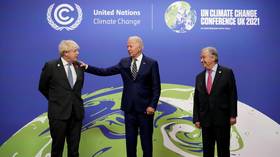The main goal of COP26 is ensuring there will be a COP27
The politicians, billionaires and film stars attending the climate carnival on the Clyde say they are ‘saving the planet’ but all they are really doing is ensuring they get to strut around lecturing the rest of us again next year.
The COP26 talks in Glasgow launched on Sunday, 31 October with enormous attention from around the world, but particularly here in the UK. World leaders flew in, showed face and shook hands and we were assured that now is the time for action.
An early and obvious criticism of the conference was the apparent indifference of the great and good to acting as role models for the rest of us. Instead, they flew in on private jets (Air Force One really being the mother of all private jets), with huge entourages in lengthy motorcades. It really was one set of rules for the rich and powerful and another set being hatched for the rest of us. For politicians who normally spend their waking hours stressing about appearances, the ‘optics’ were astonishingly bad.
Also on rt.com We’ll never solve the problems COP26 is trying to address until those in power understand how real people actually liveBut perhaps it will all be worthwhile if the conference results in meaningful action on cutting greenhouse gas emissions. And if you were to believe some of the UK government’s press releases, you might even be lulled into believing that meaningful action was already being agreed. So we’ve already had keynote pledges to end deforestation, phase out coal, and mobilise trillions for green investment.
But as Patrick Galey of the Associated Press points out, the details really don’t live up to the hype in the headlines. For example, UK ministers hosting the conference were declaring the ‘end of coal’ thanks to a deal involving 190 ‘partners’. But the deal agreed at COP26 only involved 77 new partners and only 46 of them were actual countries. Of these, just 23 were countries that were newly agreeing to end the use of coal – but 10 of them don’t actually use coal to produce electricity! On this basis, I would like to do my bit for the planet by pledging never to fly in a private jet or go for a holiday on a private island in the Bahamas – things I can only dream about doing anyway.
Still, 190 partners, that’s a serious dent in world consumption of coal, right? Er, no. According to Galey, “national signatories to the COP26 coal pledge account for around 13 per cent of global output.” The big users of coal – like the US, China, and India – haven’t signed up. However, the US did join with a group of other countries in promising to stop financing coal plants overseas – such as in poorer countries hoping to generate electricity for their citizens. So, it’s ‘coal for us, but not for you’. In short: COP26 will help to reinforce global inequality.
What about deforestation? Apparently, countries that account for 85% of global rainforests have pledged to end deforestation by 2030. But a similar deal was signed in New York back in 2014. It’s true that more countries and partners have signed up now, but actual action has been limited so far. As the WWF’s Damian Fleming pointed out to Galey: “We have been here before. Yet since (the New York declaration) a forested area greater than the size of France has been deforested.”
That said, claims about deforestation need to be put into perspective. According to the most recent edition of the UN’s five-yearly Global Forest Resources Assessment, published in 2020: “The rate of net forest loss decreased substantially over the period 1990-2020 due to a reduction in deforestation in some countries, plus increases in forest area in others through afforestation and the natural expansion of forests. The rate of net forest loss declined from 7.8 million hectares per year in the decade 1990-2000 to 5.2 million hectares per year in 2000-2010 and 4.7 million hectares per year in 2010-2020.” Forest area is still in decline, but if you thought we were running out of trees, you’d be wrong. “The world has a total forest area of 4.06 billion hectares (ha), which is 31 per cent of the total land area.”
As for all that green investment? The Glasgow Financial Alliance for Net Zero (GFANZ), co-chaired by billionaire Michael Bloomberg and the former Bank of England governor, Mark Carney, announced that 450 firms, representing an astonishing $130 trillion of assets, had committed to “use science-based guidelines to reach net-zero carbon emissions by mid-century, and to provide 2030 interim goals.”
Some scepticism is required on these headline figures. All of the big fossil-fuel investors are involved. Most of the capital is actually tied up in home mortgages or fossil-fuel infrastructure, according to critics. In reality, GFANZ is pushing governments to stump up cash to make green investments more attractive. Even if that happens, most of the spending that needs to happen on climate resilience is never going to be profitable, regardless of government sweeteners.
So if the announcements on coal, forests, and green finance really don’t add up to all that much, just what is COP26 for? I would argue the process is more important than the results. The Kyoto Protocol, signed in 1997, called for fairly limited reductions in greenhouse-gas emissions but barely succeeded and only did so thanks to setting the starting point at 1990, some creative accounting, the collapse of Eastern Europe’s economies in the 90s, the unrelated ‘dash for gas’ in the UK, and the financial crash of 2008. Moreover, it only applied to developed countries. When an attempt was made to include developing countries at Copenhagen in 2009, things fell apart, with only a fig-leaf agreement at the end keeping the process on the road.
By the time of the COP21 talks in Paris in 2015, an ambitious overall target was declared – to keep warming to below 1.5 degrees Celsius above pre-industrial levels. But the actual promised cuts were voluntary and on a country-by-country basis. Subsequent conferences have been about trying to solidify those promises and persuade richer countries to stump up the cash for climate transitions in the developing world. Promises have turned out to be a lot easier than action or signing cheques.
Also on rt.com ‘Chasing net zero to halt ‘climate change’ is an expensive folly… and COP26 is little more than a photo op for the elite’COP26 will no doubt end with another fudge that will be talked up as a success. But the real success will simply be to keep the COP process going. For world leaders, particularly in the wealthy West, the process is as important as any outcomes. Climate change provides them with a great civilising mission, an opportunity to strut about on the world stage when they achieve so little at home.
Moreover, all the easy stuff in terms of climate change has been done. To get the emissions cuts they claim to want, leaders like Joe Biden, Boris Johnson, and Emmanuel Macron are going to have to persuade the people in their countries to accept big hits to their living standards while much more populous and fast-developing countries like China and India rightly use fossil fuels to lift their populations out of poverty. Never mind selling climate deals to each other – the biggest problem for those COP26 leaders is going to be to sell severe climate action to their own voters.
Like this story? Share it with a friend!
The statements, views and opinions expressed in this column are solely those of the author and do not necessarily represent those of RT.















